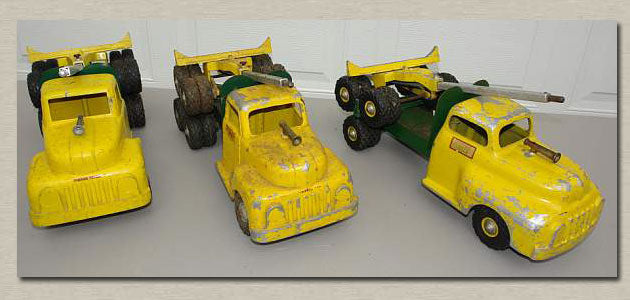All American Toy Company - In The Beginning
All American Toy Company
In the beginning...
Check back often, this page will be continually updated...
 This is where it all started in 1947 with the hand made wood patterns. Note the one on the left doesn't have a air horn mount. |
||||||
 |
||||||
|
|
||||||
|
This picture shows the three types of cast aluminum cabs that the All American Toy Co. used from 1947 to the present..
On the left is a Timber Toter using a die cast cab first introduced in 1950. This cab casting is still available as a new part. Sand cast trailers and springs were used on the first die cast trucks as the trailer die had not been completed. In the middle is a sand cast cab but with the look of the die cast cab. This cab is thick like a sand casting but has the look of a die cast cab. On the right is a sand cast cab made around 1947 or 1948. Note the painted wheels, rectangle logo on the door, six wheels and the brass air horn. Good Year diamond grip tread tires were used in the first 4 or 5 years. I would like to thank David and Cody Hull for contributing information and some photos to this history project. |
||||||
|
|
||||||
|
||||||
|
|
||||||
 |
||||||
| The early sand cast cabs have five grill bars and six on later cabs | ||||||
|
|
||||||
 |
 |
 |
||||
| Sand cast truck | Early All American logo | |||||
|
|
||||||
 |

|
 |
||||
| A very early way of attaching the wheel with threaded axle and acorn nut. | Sandcast trailer | Sandcast trailer with PAGE decal. Page & Page located in Portland, Oregon made logging trailers and equipment. Page paid the All American Toy Company 10 cents for every trailer sold with the Page name on it. In 1947 that would buy a gallon of gasoline. |
||||
|
|
||||||
|
||||||
|
|
||||||

|

|

|
||||
| The sand cast trucks have brass air horns | Early die cast cabs used this type of air horn | Later die cast trucks used this type air horn | ||||
|
|
||||||

|
 |
 |
||||
| The bottom side is the easiest way to tell the difference between a sand cast and die cast log bunk. The die cast is on the bottom. |
|
Here is a close up of a die cast spring with the casting company initials PECO | ||||

|

|
 |
||||
| This truck shows both painted and unpainted wheels. Note use of push on hub caps. Circa 1947 |
Sand cast frame has 3 mounting screws and is narrower towards the front. Note this one has original brass spindle on one side and a replacement die cast aluminum on the other. This has the wire steering tie rod system. | Some of the "J" hook steering rods have a FORD part tag. This is a left over part that was formed into the "J" hook for the exclusive air horn steering system. | ||||
|
||||||

|

|
 |
||||
| 18 wheel sand cast Timber Toter Circa 1948-1949 |
The Good Year 2100-24 Diamond Grip tires were used up to 1952-53. Note use of brass rivet to fasten the springs to the trailer | Sand cast Timber Toter. Note use of brass acorn nut. |
||||
|
|
|
|||||
| Sandcast trailer on the left Note die cast trailer on the right has the word "PAGE" cast into the trailer. The die cast trailer is available today on our parts page http://www.allamericantoyco.com/parts.html |
Note that the trailer is sand cast, as the steel die had not been completed. The red flag says: ANOTHER PAGE TRAILER | Advertisements from March 1950, Playthings magazine writes about the die cast cab. | ||||
|
|
|
|
||||
| All American Toy Co. always used steel frames with brass welded cross members. Painted with baked on enamel, steel frames were superior in strength and durability to cast frames. Today the frames are TIG welded and powder coated for years of beauty and durability. | Log bunks having a hole drilled in the outer end (cheese block) would have had the optional load of logs. | |||||
|
|
||||||
To Be Continued...





